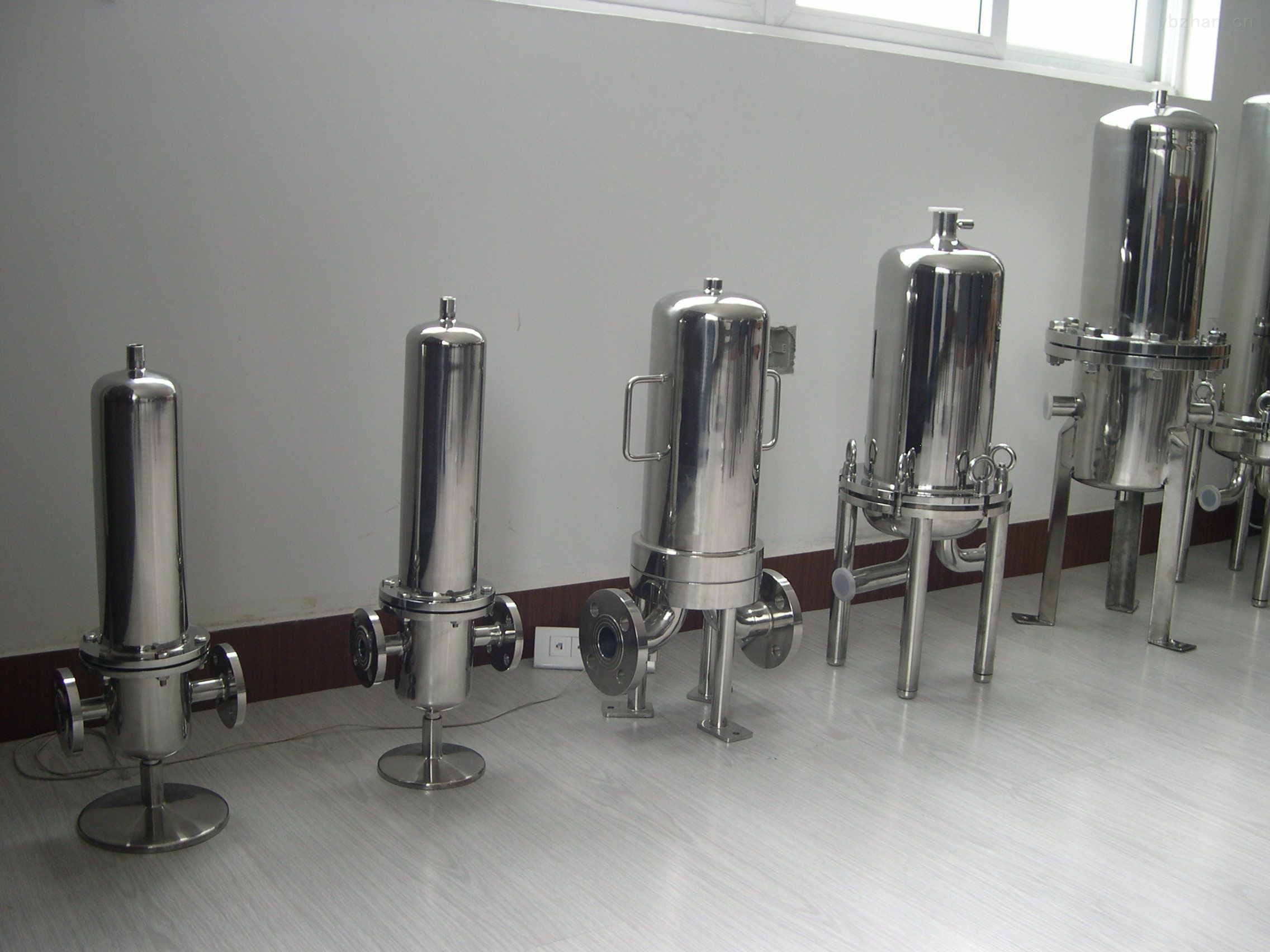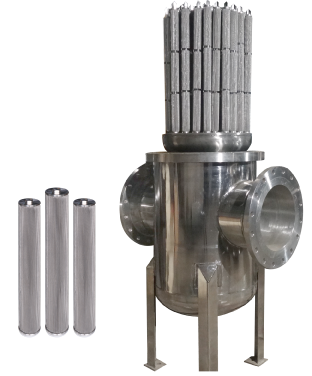In dynamic cold drying, the drying and filling processes are spatially separated. In the cold-dry room, fine powders with good fluidity are produced, and the cold-dried powdery medicines are continuously filled into ampoules in a further frozen state. In one step, the freeze-dried solution was sprayed from a high-frequency nozzle. The sprayed droplets are approximately 600 μm in diameter (adjustable between 300 and 1000 μm) and freeze into spherical particles in the cold dry room. After this freeze-drying process, the frozen powder particles will have good fluidity. These freeze-dried powder particles are conveyed into a pre-cooled dynamic cold drying chamber. After the filling is completed, the control valve closes the freezer door of the cold dry room and then enters the vacuum chamber according to a conventional freeze drying process.
Describe:
Precision Filters (also known as security filters), the shell of the cylinder is generally made of stainless steel material, the internal use of pp melt-blown, line burning, folding, titanium filter, activated carbon filter and other tubular filter elements as filter elements, According to different filtration media and design process, different filter elements are selected to meet the requirement of effluent quality. It is used for solid-liquid separation of various suspensions, high environmental requirements and high filtration precision. It is suitable for pharmaceutical, food, chemical, environmental protection, water treatment and other industrial fields.
Characteristics:
(1) high filtration accuracy and uniform pore diameter of filter core.
(2) low filtration resistance, large flux, strong ability to intercept pollution and long service life.
(3) high cleanliness of Filter Material and no pollution to filter medium.
(4) chemical solvents such as acid resistance, alkali resistance.
(5) high strength, high temperature resistance, not easy deformation of filter elements.
(6) low price, low operating cost, easy cleaning and replaceable filter elements.
Applications:
It is used for solid-liquid separation of various suspensions, high environmental requirements and high filtration precision. It is suitable for pharmaceutical, food, chemical, environmental protection, water treatment and other industrial fields. Tank material can be divided into fiberglass can, carbon steel tank, stainless steel can, but also according to customer requirements.
Precision Filters,Ss Precision Filters,Stainless Steel Precision Filters,Flange Stainless Steel Precision Filter Henan Sinofiltec Technology Co.,Ltd , https://www.sinofiltec.com
The structure of a dynamic freeze dryer is basically the same as a conventional freeze drying device with a cold dry chamber and a cold trap. Unlike heatable shelves, dynamic dryers have a heated drum. The low speed of the drum ensures that the product can be gently cycled in the drum. The continuous monitoring of the temperature sensor makes the powdered product very close to the temperature of the production process of the cold-dried product. The detected temperature data clearly gives the temperature signal at the end of the freeze. Finally, the drum rotates in the opposite direction, using the opening that is open to the front to remove the frozen product ticket from the dryer.
In the traditional freeze-drying equipment, so-called "edge effect" often occurs, and in dynamic freeze-drying, this effect does not occur due to the product's cyclic rolling and continuous mixing and stirring, thus allowing a temperature difference on the surface of the drum. It also makes the equipment audit and quality certification easier.
Better performance with a dynamic freeze-drying process requires only about 1 s to complete the freezing process. Common freeze-drying processes include common buffer freeze-concentration (protein instability) and ice crystal growth (affecting the stability of microorganisms or destroying tissue) and other risks Reduced to a minimum. Also, since the freezing process starts from the outside to the inside of the surface of the product particle and freezes without surface adhesion of the powder particles, there is a free passage of water vapor. In the drying process, the ice frozen on the surface of the powder particles gradually penetrates into the center of the particles. The secondary cold-drying, that is, secondary dehydration, begins with the ice leaving the surface of the powder particles. This allows the powder particle product to be dried within a short time after contact with the surface of the drum, which is equivalent to the time of the secondary cold drying. After drying, the water volatilization resistance of the product accounts for 80% of the total resistance, and the remaining 20% ​​is produced by the cold dry chamber and ampoules. Although in the dynamic cold-drying process, the resistance to evaporation of water is also caused by the dry product layer, since the maximum diameter of the dynamic cold-dry powder particles is between 300 and 500 μm, it is much smaller than the traditional static freeze-drying. Therefore, its water volatilization resistance is also significantly lower than the traditional freeze-drying technology. This also fully embodies the new features of dynamic cold-dry equipment design, that is, without any measures to reduce the volatilization resistance of water. In addition, powder particles under dynamic cold-drying technology have significantly larger surface area available for heat transfer and mass exchange than conventional freeze-drying techniques.
Saving time and effort These factors not only enable the dynamic cold-drying equipment to complete the cold-drying of the product faster, but also have prominent advantages in the automation of loading and unloading, omitting the complicated feeding system and the feeding system. All products can use gravity to fall from the dryer to the storage container. When the final product is filled, the finer powder particles have better fluidity, and the operation can also be separated from the production process in time and space separately. In addition, it is also possible to fill batches of products of the same batch according to different quantities, and even to fill with incompatible materials which must be compatible before use. Dynamic freeze-drying equipment does not require the minimum height, shape, size, and bottom thickness of conventional freeze-drying equipment because it requires storage containers that do not need to meet the requirements of the freeze-drying process equipment. Since the transport of dynamic cold-dried products depends on gravity, the entire equipment is in a closed state at work, so the hygiene requirements in the production process and the protection requirements for toxic products are all easier to implement.
The author of this article, M. Plitzko, is a process technology engineer at Meridion Engineering Technologies, and B. Luy is president of Meridion.


